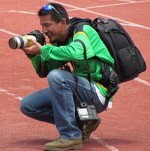After a reporter files a story, the work isn’t really done. Sometimes the article takes on a life of its own, leading to some kind of change or unexpected solution. The same thing goes for a photo.
Sometimes journalism rearranges the way a reporter or photographer carries on with his or her own life.
Here we share stories of Cebu Daily News ‘siloys’ and the memorable connections they make.
OFW SENDS HELP AFTER SEEING ACCIDENT PHOTO
By Wenceslao ‘Junjie’ Mendoza, Senior Photographer
I was assigned to cover the groundbreaking of a shelter project for supertyphoon Yolanda survivors in Bogo City.
On the way north, in Tabogon town, we noticed a road accident. A truck had fallen into a ravine. I asked the driver of the coaster bringing our group of journalists to stop. The truck passengers, all victims, turned out to be sugarcane field workers – sacadas. They had been picked up early that morning from their homes and were being brought to a hacienda in Bogo when the truck was forced off the road by another cargo truck that overtook it.
Paramedics arrived soon after we got there. I went down the ravine and saw injured people scattered around.
I didn’t have enough time to get their names. I just clicked away.
Among the survivors were two couples. The husbands were cradling their injured wives in their arms. That was all they could do as they sat in the back of another truck, waiting to be taken to the hospital.
I’ve been a photojournalist for more than 16 years. Capturing that kind of photo doesn’t happen every day.

Two pairs of sugarcane workers are among the injured passengers of a cargo truck that fell into a ravine on Dec. 21, 2013.
WHAT HAPPENED AFTER
In Singapore, a Filipino businessman saw the photo posted in the CDN website and read the story. He was so moved he called Vice Gov. Agnes Magpale, a close friend, in Cebu.
He knew the farm workers were poor and wanted to give P10,000 to each couple.
“I told him I could look for the workers after Christmas, but he insisted that it shouldn’t wait. Kinahanglan sa Pasko gyud,” said Magpale.
She first tried calling up a CDN editor to locate the victims but we didn’t have the victims’ names available.
Magpale made the rounds on Dec. 25, showing a copy of CDN’s published photo to contacts in Bogo and Tabogon.
She found Elena Tuled and her spouse in the hospital of the Bogo-Medellin Sugar Milling Company. The other injured couple was traced to their home in Tabogon. The cash assistance was given to Tuled and Maelord Monares, and their partners on Dec. 26.
“It’s really a beautiful photo,” said the vice governor.
At first, all you see is the pain and poverty. Then you notice the tender love of the victims./with Eileen G. Mangubat
‘STAY ALERT WITH YOUR EYES, ALL YOUR SENSES’
By Amelito Tecson, Photographer
The first C-130 plane was heading to Tacloban City from Mactan after supertyphoon Yolanda. Editors wondered who to send, knowing from early reports that the area was devastated.
When I was asked to go, I quietly prepared my gear – camera, laptop, water bottle, a few canned goods and biscuits.
(Lito was still gungho about field work after non-stop disaster assignments. In August 16, he covered the sinking of the MV St. Thomas Aquinas off Talisay City, where over 116 passengers died. Then he went to Bohol after the October 15 earthquake. – Editors)
When I arrived in Tacloban City Sunday morning, the devastation shocked me. I had never seen that extent of damage in my 15 years on the job. I didn’t flinch at the sight of lifeless bodies on the road until I saw a plastic box by the seashore near City Hall. The legs of a one-year-old child, already dead, stuck out. That really affected me. I tried hard to stay focused, pero lisud kaayo. (but it was very difficult). It doesn’t help to be emotional during a coverage so I carried on.
We saw the looting of a store but I didn’t feel any personal danger. Residents who saw us smiled, happy to see the media around. Some people gave me slips of paper with the names of relatives and their phone numbers, hoping I could relay their situation.
I didn’t expose my camera when I moved around unless it was necessary.
The first photos I sent to CDN were of prisoners who had escaped from the Tacloban jail. They were pushed down to the ground by authorities who recaptured them.

Jail and police officers subdue three inmates of the Tacloban City jail after they attempted to escape in this Nov. 10 file photo. (CDN PHOTO/LITO TECSON)
I had just arrived in Tacloban City Hall after a long walk from the airport. I heard gunfire and thought there was a food riot going on. People were running away and an army soldier fired warning shots. I took cover behind a wall of the City Hall, and started taking photos until two men were pinned to the ground and handcuffed. I went nearer to get closer shots, when I sensed it was safe.
In covering events under extreme stress, it’s important to stay focused. I kept my feelings to myself.
As photojournalists, we are trained to always stay alert with our eyes. But during a disaster, all senses have to be alert.
RELATED STORIES:
Going undercover in Pasil A look back at the ‘strongest woman’ Chasing stories and mama dutiesDisclaimer: The comments uploaded on this site do not necessarily represent or reflect the views of management and owner of Cebudailynews. We reserve the right to exclude comments that we deem to be inconsistent with our editorial standards.


